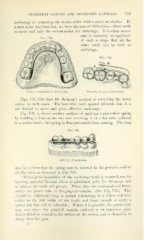Page 755 - My FlipBook
P. 755
PROMINENT CANINES AND DEPRESSED LATERALS. 753
anchorage in retracting the canine either with a screw or elastics. If
a first molar has been lost, we have the sum of difficulties,—three teeth
to move and only the second molar for anchorage. It is often neces-
sary to construct an appliance
r38
of such a shape that all the
other teeth can be used as
anchorage.
Fig. 739.
Jackson's appliance for lower arch. Flat tube for piano-wire spring.
Figs. 737, 738 show Dr. Jackson's method of retracting the lower
canine in such cases. The base wire rests against all teeth that it is
not desired to move and gives effective anchorage.
Fig. 739, A, shows another method of applying a piano-wire spring
by bending a loop on one end and inserting it in a flat tube soldered
to a molar band ; the spring is thus prevented from turning. The loop
Fig. 740.
Stability of anchorage.
may be so bent that the spring may be inserted in the posterior end of
the flat tube, as shown at b, Fig. 739.
'' When great immobility of the anchorage tooth is required, use for
banding material German silver or platinized gold, No. 30 gauge and
as wide as the tooth will permit. When these are contoured and fitted,
solder the power tube at the gingival mai'gin. (See Fig. 740.) This
should be sufficiently long to permit reinforcing it at either end with
solder to the full width of the tooth, and large enough to carry a
power rod that will be inflexible. Where it is possible, the power tube
may rest above the gingival margin, soldered to an extension plate
that is fitted or swaged to the surface of the crown, and so shaped as to
freely clear the gum.
48


